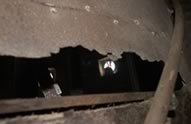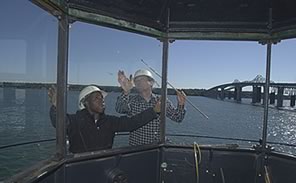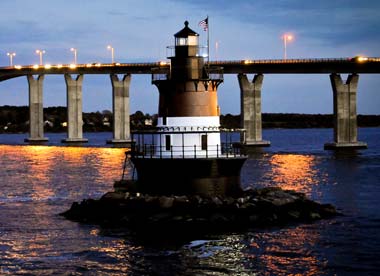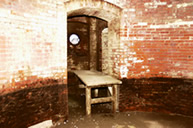2003 – Lighthouse Construction

The lighthouse as it sat in May 2003, prior to construction. Note its deteriorated condition, paint all but missing from the structure. According to Keith Lescarbeau, the contractor hired by the state Department of Transportation to handle the renovations, the rusting wasn’t a bad thing. Inherent in iron construction is oxidation that, while its appearance looks bad, is actually protecting the structure from further deterioration.

Federal Grant
An aerial shot in June prior to reconstruction. The Friends were awarded a $500,000 Transportation Equity Act for the 21st Century (TEA-21) federal grant in conjunction with the Rhode Island State Department of Transportation. The grant was administered by RIDOT in the form of construction credits.
Newport Collaborative was the architect for the project, and the contractor hired was Abcore Restoration of Narragansett, among whose other notable projects include the restoration of the Towers in Narragansett.
Clean Harbors
In the 62 years since it was last inhabited, the lighthouse was the home to generations of pigeons, cormorants and seagulls. An estimate of an amazing 52 tons of guano was abated by Clean Harbors, a hazardous waste removal company hired to do the job. Much to the dismay of local farmers, the guano was required by contract to be disposed.

Discolored Wall
In the basement level, the guano depth was over 4 feet in some places. While it may look like the wall is painted, the discoloration is actually from the effects of the guano.
Flooring
The upper levels of the structure show severe damage from the guano. The wooden floors and ceilings are soaked in bird droppings, and the metal walls have been corroded from the acidic property of the guano. The original contract called for the removal of the guano and the painting of the interior, but because of extensive interior damage discovered after the guano abatement, the contract was rewritten to exclude any additional interior reconstruction. The contract credit slated for the interior was used instead to rebuild exterior decking and columns which were initially to be removed but not replaced. It is estimated that the amount needed to rebuild the interior may equal or exceed the $500,000 used to repaint the exterior.



Lantern Room & Cabinets
The lantern room was devoid of its glass, allowing the birds free reign of the lighthouse. Glass in all of the windows and portholes in the structure was missing, the effects of 62 years of storms damage and vandalism. Ironically, there was very little vandalism at the lighthouse since it is such a difficult place to get to. Wooden cabinets are still in place inside the structure.
Conical Shape
The lighthouse is an interesting architectural structure in its conical shape. While the shell is made of iron, the interior is made mostly of brick, steel, and some wood. Here the staircase is shown on the second level.
Rotted Wall
The guano levels on the upper floors reached as high as the window sills, and this metal wall decayed because of the guano.
Collaborative People
Keith Lescarbeau met regularly with representatives of Newport Collaborative, the architects for the project.
Shrouded Light
Throughout the summer of 2003, Abcore Restoration removed the iron scaling from the lighthouse, then sandblasted the entire structure to prepare it for painting. A coat of marine epoxy primer was then applied directly to the iron.



Missing Paint
The first phase of the repainting was to contain the rust and old paint being removed from the lighthouse. Because there was so little paint remaining on the structure, the lead abatement procedure wasn’t a factor,
making the job easier for the contractor.
Painting Light
In September, Bass River Painting of Middletown applied the final coat of marine epoxy in the original lighthouse color scheme.
Replacing Glass
Keith Lescarbeau and Kenny Reid of Abcore Restoration place glass in the lantern room in October. It was imperative to seal the lighthouse from the birds, so the lantern room was finished with tempered double pane glass. The windows were sealed with original brass molding that had been refinished by Lescarbeau. Each porthole, window, and door in the lower levels was sealed with marine painted stainless steel, making access impossible for birds and humans.
Grinding Columns
Metal railings on two of the levels and the columns and roof line of the
main deck were demolished then replaced. Here Rob Winter of Coastal Iron
Works welds part of the railing on the upper deck. The original cast iron
columns of the main deck were replicated by Beckman Boatbuilders of Exeter
who cast the new columns in gel coated fiberglass, making them impervious to
the salt water elements.
1918 Crack
The base of the lighthouse had been badly damaged by the severe winter of
1918 when Narragansett Bay was encased in ice. After being repaired tin
1922, the cracks reformed during the 1938 hurricane and were never repaired,
allowing birds more access to the structure. During the renovations, Abcore
Restoration place two 6 inch stainless steel bands around the base to
prevent further storm damage to the structure.



Solar Beacon
The Coast Guard Aid to Navigation approved a flashing light for the lighthouse in October, and in December a solar powered beacon was placed in the lantern room, lighting the structure for the first time in 62 years. The official navigational charts for Narragansett Bay will now show that Plum Beach Lighthouse is a private aid to navigation, #19310. Its flashing configuration is the same as it was in 1899–it flashes every 5 seconds with a one second duration followed by 4 seconds of darkness. The beacon was purchased from Waterways Navigation of Guilford, NH, and is the type of beacon generally used for buoys, but was chosen because of its maintenance free qualities and is designed to run for 5 years. It can work up to six days without sunshine.



After Dark
Once the lantern room received its new light, a trip at night over the Jamestown Bridge revealed that the flashing beacon alone wasn’t enough to highlight the lighthouse. It was decided to add accent lighting to the structure, so three solar powered fluorescent lights were purchased from Solar Direct of Stuart, Florida. They were added to the lighthouse during Christmas week, giving the lighthouse a new look from dusk to six hours into the evening. A generous donation by Jeff and Kathy Camans of Jamestown made the accent lighting possible.
ce & Light
The winter of 2004 was one of the coldest on record in the Northeast and the lighthouse was captured amidst sea smoke on January 16. Air temperature was -4, wind was out of the north at 25 mph.
Historic Plaque
In 1988, the RI Historic Commission placed all of the State’s lighthouses on the National Registry of Historic Places, and a commemorative plaque was placed on the structure in December.



